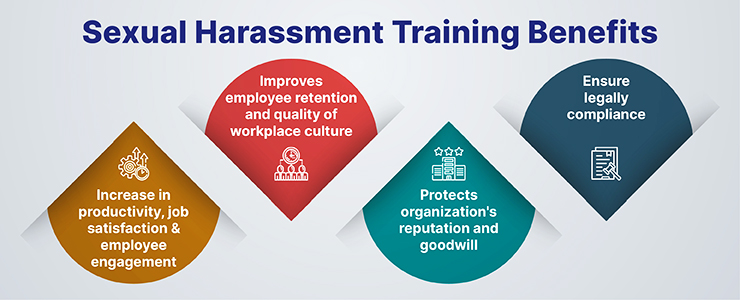What Is Sexual Harassment Training?
Sexual harassment training is a process that educates employees about appropriate and inappropriate workplace behaviors. It empowers them with the necessary knowledge and tools to identify and address any potentially offensive actions. Although such training isn’t mandatory everywhere, U.S. employers are bound by law to ensure a workplace free from harassment. Therefore, it’s strongly recommended that businesses offer their employees training on how to prevent sexual harassment.
Experiencing sexual harassment can be detrimental to an employee. The Equal Employment Opportunity Commission (EEOC) identifies it as a discrimination violation under Title VII of the Civil Rights Act of 1964. Beyond the emotional trauma and reduced work efficacy, cases of sexual harassment can lead to legal disputes. These are not only draining in terms of time and resources but also carry significant financial risks for employers. The negative press from such incidents can further amplify the economic damages to a company.
Importance of Sexual Harassment Training?
Now more than ever, employers must prioritize providing anti-harassment training to both employees and supervisors. Such training is designed to equip individuals with essential tools and knowledge to maintain appropriate conduct within the workplace. While the content of these courses can differ, they typically encompass fundamental aspects such as major federal laws on sexual harassment, their implications in the work environment, legal definitions of harassment and discrimination, company protocols, and beyond.
Defining Sexual Harassment
The EEOC defines sexual harassment as unwelcome behaviors including sexual advances, requests for sexual favors, and other verbal or physical actions of a sexual nature in professional or educational settings. These behaviors may not always be overtly sexual. For instance, remarks made based on one’s gender, such as derogatory jokes about women, fall under sexual harassment.
Some prevalent forms of sexual harassment in the workplace are:
- Unwanted physical contact like touching or pinching
- Making obscene or sexual comments or gestures
- Sharing unsolicited pornographic images or videos
- Asking for sexual favors without consent
- Disseminating sexually explicit letters, calls, or other materials
It’s important to note that any unwelcome behavior targeted at someone can be deemed as harassment. Sexual harassment stands out as the most common form, with recent data suggesting that over half of all employees have faced it in various ways. Though behaviors like occasional teasing, casual remarks, and singular incidents aren’t necessarily illegal, it becomes a legal concern when such actions are so recurrent that they cultivate a hostile work atmosphere.
What Is the Purpose of Sexual Harassment Training?
Sexual harassment training is formulated to guide employees in identifying and addressing behaviors that infringe upon an individual’s respect, privacy, well-being, or personal boundaries. Anti-harassment training’s primary objective is to arm employees with the understanding and resources to pinpoint, prevent, and report unsuitable behaviors in the workplace. This training is especially crucial for individuals in leadership roles, as they bear the responsibility to rectify such situations when they arise.
While flagrant acts of sexual harassment are typically clear-cut, more understated and concealed forms can be harder to discern. This subtler harassment, characterized by unsolicited sexual comments, jests, or suggestions, can foster an antagonistic work environment or evolve into quid pro quo harassment if unaddressed. Quid pro quo harassment entails employment decisions hinging on an employee’s acceptance or rebuff of unsought sexual propositions. A scenario exemplifying this would be an employee being terminated for declining a supervisor’s date invitation.
The goal of sexual harassment training is to enlighten employers about recognizing both overt and hidden harassment in the workplace. Sexual harassment can affect anyone, regardless of their industry, gender, or age. Ultimately, every employee deserves to feel safe and respected in their work environment, making sexual harassment training a valuable asset for both employers and their workforce.
[Also Read: Understanding Sexual Harassment: How to Guard Yourself Against Workplace Harassment]
Employee Training
Remember, employee training is meant not just for potential victims of sexual harassment but also for the harasser. The training should send a clear message condemning sexual harassment and emphasize your commitment to providing a safe workplace to all employees.
Here are the topics that your employee training should cover
- Your policy against harassment
- What is unwelcome conduct
- Hostile work environment, quid pro quo, and bullying
- How to deal with harassment
- Bystander Intervention
- Illegal retaliation
- How to file complaints
- Company procedures for investigation and resolution
- Federal, state, and local anti-harassment laws
- Protections offered by the law for victims of harassment
- The training should also include a list of resources for sexual harassment victims, including addresses, helpline numbers, and websites that victims can use.
Supervisor Training
Along with the topics above, supervisor training should also include topics such as how to create a harassment-free workplace and how supervisors should deal with incidents of sexual harassment. Here’s what your training should include:
A clear message is that sexual harassment will not be tolerated in your organization, and it’s the supervisor’s responsibility to ensure that.
- How supervisors should react if they witness harassment
- How to handle complaints
- What a supervisor should do if he or she is accused of harassment
- How to investigate and resolve complaints
Choose interactive training programs
Your training program should include interactive activities. Such training would make it easy for employees to understand –
- Which behaviors are considered harassment
- How to react under uncomfortable situations
- How to intervene if you witness harassment
- How supervisors should handle a complaint
- How can supervisors prevent harassment from happening
Relevant Content
Ensure that the training content is relevant to your business. The training should be easy to understand. A training designed for office workers will just not work if yours is a restaurant.
An office setting puts emphasis on employees’ interaction with other employees, while a restaurant setting demands training that covers employees’ interaction with customers and vendors as well.
Similarly, a recorded webinar won’t work if you have hundreds of employees, and online harassment training would work better.
State and Local Laws
Likewise, the sexual harassment laws differ by state. Ensure that the training program meets your state’s standards for training, and covers state and local anti-harassment laws.
Duration of the training program
Equally important is the duration of the training program. Some states have strict standards for this. The length of the training program should meet the state standards.
For example, in California, employee training can be 1-hour long, but supervisor training has to be 2 hours in length. Similarly, in Connecticut, only 2-hour long training programs are acceptable.
Updated training material
The last point for you to check is how updated the training material is. The training material should match the most recent updates to the law and court orders.
Sexual harassment training is now becoming a compulsion across the US. So be prepared for it. Sexual harassment lawsuits can be really costly. There are severe penalties for failing to address sexual harassment at work and, in some cases, possible jail time.
But, if you can prove that you trained your employees and that you have a system in place for preventing harassment and addressing complaints, it could help avoid liability.
What Is Covered During Sexual Harassment Training?
The content of sexual harassment training courses can vary widely, ranging from basic concepts and definitions to intricate legal terminology. At a minimum, most of these courses educate employees on what constitutes sexual harassment, the legal boundaries of discrimination and harassment, pertinent local and federal laws, and specific company policies on the issue. These courses often employ interactive materials and realistic situations to help employees distinguish between proper and improper workplace behavior.
Subjects typically broached during sexual harassment training encompass:
- Ethical standards and compliance
- Illustrative instances of sexual harassment
- Forms of sexual harassment (like quid pro quo and hostile work environment)
- Measures to counteract harassment and discrimination
- Steps to take if one encounters sexual harassment
- How to react when witnessing harassment at work
For those in managerial roles, training usually details the steps to take upon receiving an employee complaint, techniques to manage the situation with professionalism and empathy, and methods to methodically investigate and record the incident. Since organizational culture can influence the prevention of harassment and discrimination, addressing this topic is valuable. Given that managers often bear responsibility in the event of complaints, training them in this domain proves invaluable for companies.
Who Will Encounter Sexual Harassment Training?
Most employees across the states will likely undergo sexual harassment training during their professional journey. Though not mandatory in every state, all 50 states recommend such training.
Mandatory sexual harassment training is enforced in:
- California
- Connecticut
- Delaware
- Illinois
- Maine
- New York State
- New York City
It’s crucial for both staff and supervisors to understand how to respond if they witness sexual harassment or become its victim. At Impactly, we provide evidence-based, subscription-oriented solutions, featuring online anti-harassment courses tailored to fit your organization’s needs. Explore our plans and pricing to learn more about our unique training modules, crafted to enhance workplace culture and mitigate risks.
You can also drop an email to us at info@empowerelearning.com; we’ll be happy to help you.







